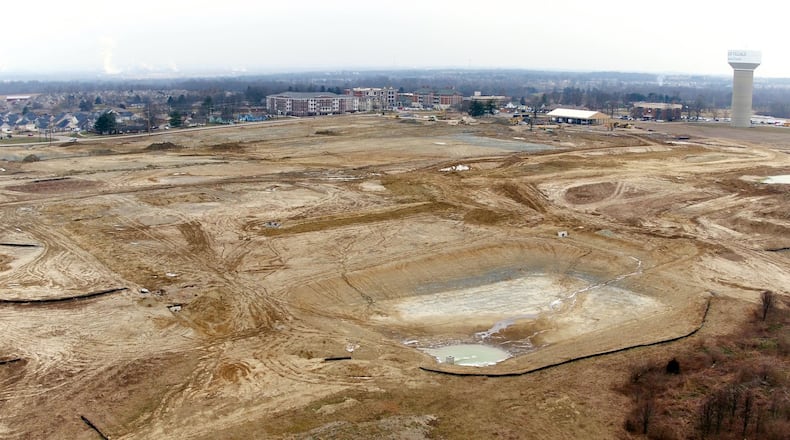First, however, they often wind up at meetings of county commissioners, who decide development issues in unincorporated parts of the community. That’s where much of the development is taking place and where it seems likely to continue in coming decades.
“This 70 acres is going to have houses on it,” Warren County Commissioner Dave Young said during a February hearing over development of a farm, north of Lebanon.
RELATED: Warren jumps to 10th largest county in Ohio
Young and Commissioner Tom Grossmann urged neighbors opposing the development to keep in mind that their property values are likely to go up.
“This is our castle. We’d like to stay here,” resident Randy Powell replied.
Self-proclaimed as “Ohio’s Largest Playground,” Warren County — nestled between Dayton and Cincinnati, interstates 75 and 71 and the Great and Little Miami rivers — is now Ohio’s 10th largest county, according to U.S. Census estimates.
Last year, 3,300 more residents moved to the county, which already features attractions like Kings Island amusement park, the Great Wolf Lodge and Miami Valley Gaming and Racing.
Since 1980, the population has more than doubled from 99,276 to 232,170, according to the Census.
That has brought construction growth.
PAYROLL PROJECT: See how much Warren County’s highest paid employees earn
Over the past decade, 6,105 new single-family homes have been permitted, just in the unincorporated areas of the county, according to county records.
‘Stretched pretty thin’
All the growth has Warren County Engineer Neil Tunison scrambling for enough money to widen Ohio 63 and other roads in the midst of the development.
In March, Tunison was part of a group of county officials appealing to the Lebanon school board for support for using a special district diverting taxes otherwise going to the schools and other county entities to raise $25 million for road work west of the city.
Last week, Tunison said he continued to work on widening Ohio 63 up to Ohio 741, and other projects in that area, but was otherwise lacking funds for projects like a $15 million bridge over the Little Miami, near the Peters Cartridge factory redevelopment.
MORE: Warren County tourism credited for $1.2 billion in 2017 sales
“I’m being stretched pretty thin,” he said. “I don’t have money to put in some of these larger projects.”
The Ohio 63 widening is expected to ease existing traffic congestion and gridlock expected to come with development of the corridor that leads past state land envisioned for more economic development, the Union Village planned community and into Lebanon.
The first phase of Union Village, projected to eventually be home to 12,000 residents on 1,400 acres, is under construction north of Ohio 63 on Ohio 741 between Springboro and Mason.
Seeking protection
Some residents have called for better roads to handle growing traffic and for steps to protect the county’s rural character.
Outside Waynesville, residents of unincorporated Wayne Twp. will decide a referendum on a development that would include 39 homes on 40.7 acres.
Residents on Greentree Road, west of Lebanon, rose up in opposition to the $15 million Warren County Sports Park at Union Village.
The sports complex is just north of Union Village and the main campus of the Otterbein SeniorLife retirement community.
Supporters expect the sports complex to draw players and supporters from around the world, filling hotels, restaurants and attractions. The residents expect traffic jams and bright field lights disturbing their evenings.
Other county residents filed lawsuits against the county, one taken all the way to the Ohio Supreme Court, in opposition to commercial developments in residential areas.
“This activity is extremely damaging to the value of our property,” retired Warren County Common Pleas Judge P. Daniel Fedders wrote in response to a neighbor’s Supreme Court appeal of the county permitting a septic-tank cleaning business in the neighborhood.
The Supreme Court declined to take up the appeal.
“We do intend to take other legal actions to protect our property and the surrounding neighborhood,“ Fedders added in a statement earlier this year. None has apparently been filed yet.
The Incredible County
Some long-time residents are thrilled by the growth.
Proctor & Gamble is expanding its campus in Mason, and Amazon is building a million square foot fulfillment center across Ohio 63 from the racino, just east of I-75 and a Premium Outlets Mall.
For outdoor recreation, there are state and local parks, access to the two rivers and what is billed as one of the nation’s longest trail networks.
“For me personally growing up in Lebanon, having always lived in Warren County, there’s a reason they call it the Incredible County,” said Mike Williams, who is developing planned communities on both sides of Lebanon, the county seat.
“People want to have the feeling they’re in a little more rural setting but have access” to shopping and other services, Williams said.
Williams is among those sued in a lawsuit brought by neighbors of the Meadow Lane Farm, north of Lebanon, approved in February by the county commissioners for a planned residential community, despite the objections of neighbors.
The development is in Turtlecreek Twp., where 780 new homes have been permitted from 2009-2018, according to county records. Over the next 30 years, Union Village itself is permitted to add up to 4,500 homes to the township.
“The goal was to provide an area for growth,” said Bob Turner, the developer from South Carolina overseeing Union Village, “so that it doesn’t sprawl.”
Turner credited Warren County with being cooperative with development.
He pointed to this approach to proposed growth, along with the location between Cincinnati and Dayton, as key benefits propelling the county’s growth.
More growth expected
Warren County is also near Indiana and Kentucky and within commuting distance of Columbus.
This gives residents a broad choice of potential employers, some of which, like Amazon, are moving to Warren County.
Two projects planned by the county indicate growth will continue in the unincorporated areas.
Sewer systems are to be installed in areas east of Waynesville, around Caesar Creek Lake, near I-71, and Red Lion, a small town on Ohio 741 between Springboro and Mason. These projects would enable construction of multiple homes on more than 1,500 undeveloped acres.
While some of the county’s school districts are struggling with growth, others are leveling off.
In the Mason City Schools, the county’s largest district, enrollment is actually trending down.
Topping out at 11,013 in 2010-2011, the district is expected to “gradually decrease to under 10,000 students,” according to Tracy Carson, public information officer in the district.
The district, just north of the Hamilton-Warren County line, generally serves Mason and Deerfield Twp., the county’s most populace community.
From 1995 to 2010, the district added 600 students a year, according to district data.
“Today, enrollment has stabilized. The district’s largest class, the Class of 2018, had 920 graduates while there are 660 first graders,” Carson said via email.
Lebanon City Schools, which generally serves students in the city and Turtlecreek Twp., has seen a similar leveling trend.
“To this point, the Lebanon School District has not experienced the same circumstances that lead to rapid growths in student enrollment. Could that happen? I think we all know that it could happen here. However, we are grateful that the growth is happening at a pace that we can adjust to accordingly,” Superintendent Todd Yohey said.
The superintendent was asked to weigh the pros and cons of growth in Warren County.
“Pros of student growth include an indicator that your community and school district is attractive to people seeking a place to move. Cons include a lack of sustainable revenue to educate additional students,” Yohey said.
In the May 7 election, Lebanon school district voters consider an additional 4.99-mill, four-year levy.
About the Author

